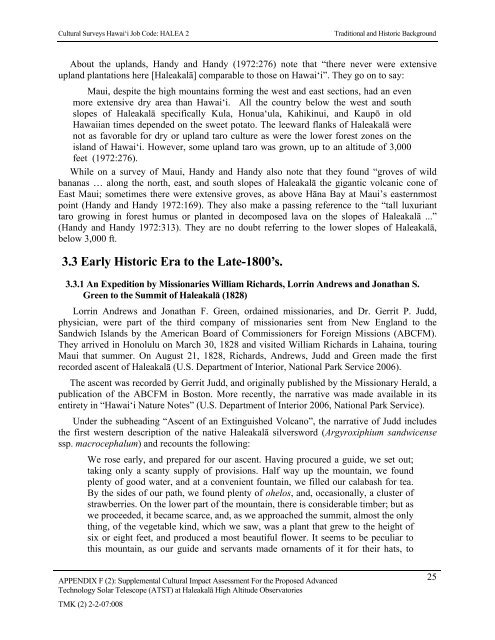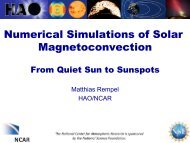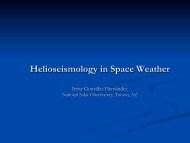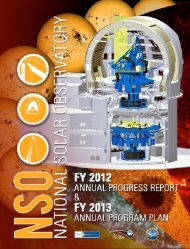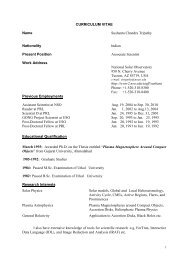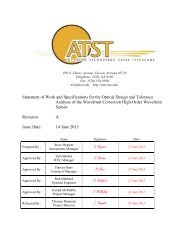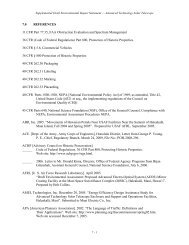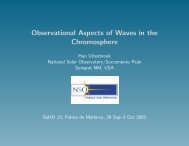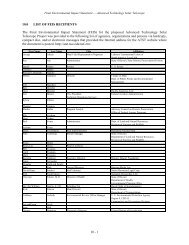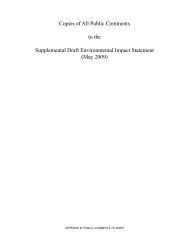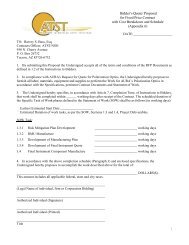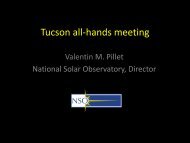F2 - ATST
F2 - ATST
F2 - ATST
Create successful ePaper yourself
Turn your PDF publications into a flip-book with our unique Google optimized e-Paper software.
Cultural Surveys Hawai‘i Job Code: HALEA 2Traditional and Historic BackgroundAbout the uplands, Handy and Handy (1972:276) note that “there never were extensiveupland plantations here [Haleakalā] comparable to those on Hawai‘i”. They go on to say:Maui, despite the high mountains forming the west and east sections, had an evenmore extensive dry area than Hawai‘i. All the country below the west and southslopes of Haleakalā specifically Kula, Honua‘ula, Kahikinui, and Kaupō in oldHawaiian times depended on the sweet potato. The leeward flanks of Haleakalā werenot as favorable for dry or upland taro culture as were the lower forest zones on theisland of Hawai‘i. However, some upland taro was grown, up to an altitude of 3,000feet (1972:276).While on a survey of Maui, Handy and Handy also note that they found “groves of wildbananas … along the north, east, and south slopes of Haleakalā the gigantic volcanic cone ofEast Maui; sometimes there were extensive groves, as above Hāna Bay at Maui’s easternmostpoint (Handy and Handy 1972:169). They also make a passing reference to the “tall luxurianttaro growing in forest humus or planted in decomposed lava on the slopes of Haleakalā ...”(Handy and Handy 1972:313). They are no doubt referring to the lower slopes of Haleakalā,below 3,000 ft.3.3 Early Historic Era to the Late-1800’s.3.3.1 An Expedition by Missionaries William Richards, Lorrin Andrews and Jonathan S.Green to the Summit of Haleakalā (1828)Lorrin Andrews and Jonathan F. Green, ordained missionaries, and Dr. Gerrit P. Judd,physician, were part of the third company of missionaries sent from New England to theSandwich Islands by the American Board of Commissioners for Foreign Missions (ABCFM).They arrived in Honolulu on March 30, 1828 and visited William Richards in Lahaina, touringMaui that summer. On August 21, 1828, Richards, Andrews, Judd and Green made the firstrecorded ascent of Haleakalā (U.S. Department of Interior, National Park Service 2006).The ascent was recorded by Gerrit Judd, and originally published by the Missionary Herald, apublication of the ABCFM in Boston. More recently, the narrative was made available in itsentirety in “Hawai‘i Nature Notes” (U.S. Department of Interior 2006, National Park Service).Under the subheading “Ascent of an Extinguished Volcano”, the narrative of Judd includesthe first western description of the native Haleakalā silversword (Argyroxiphium sandwicensessp. macrocephalum) and recounts the following:We rose early, and prepared for our ascent. Having procured a guide, we set out;taking only a scanty supply of provisions. Half way up the mountain, we foundplenty of good water, and at a convenient fountain, we filled our calabash for tea.By the sides of our path, we found plenty of ohelos, and, occasionally, a cluster ofstrawberries. On the lower part of the mountain, there is considerable timber; but aswe proceeded, it became scarce, and, as we approached the summit, almost the onlything, of the vegetable kind, which we saw, was a plant that grew to the height ofsix or eight feet, and produced a most beautiful flower. It seems to be peculiar tothis mountain, as our guide and servants made ornaments of it for their hats, toAPPENDIX F (2): Supplemental Cultural Impact Assessment For the Proposed Advanced 25Technology Solar Telescope (<strong>ATST</strong>) at Haleakalā High Altitude ObservatoriesTMK (2) 2-2-07:008


